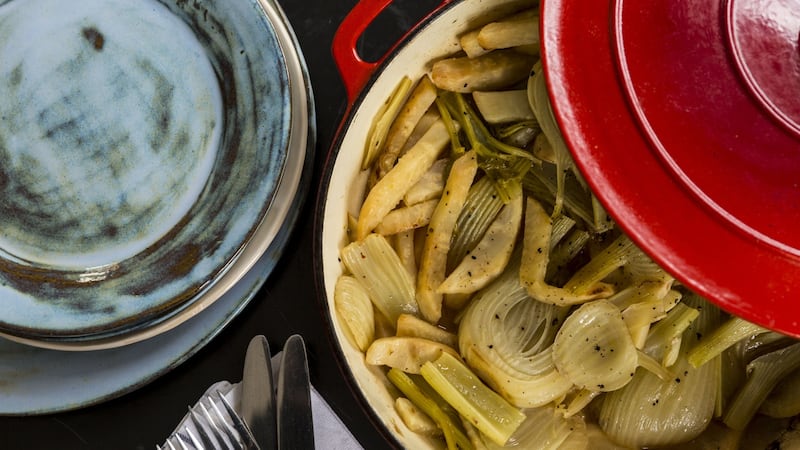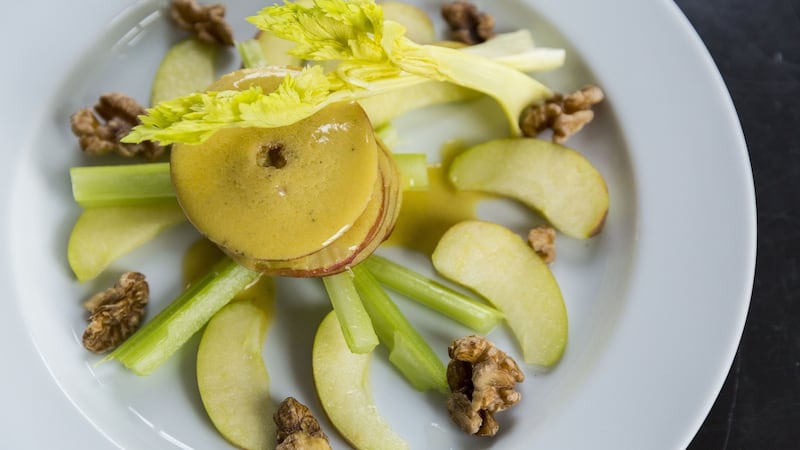Celeriac and celery are two wonderfully pliable ingredients that are very closely related. They are members of the same family and are often confused for being from the same plant.
Celeriac, otherwise misleadingly known as celery root, is not actually the root of the celery plant. Celeriac grows conversely to celery; it is primarily used for its root. If you are lucky enough to get celeriac freshly picked, though, the stalks and leaves are also edible and are, like most things, delicious when slowly cooked in butter.
Celeriac is a winter vegetable with a shelf life of up to eight months when stored properly. It’s very versatile, convenient – can be eaten raw or cooked – and it’s easy to prepare, which often leads me to wonder why it’s not more prevalent and appreciated.
Even though celeriac is a root vegetable, it grows mainly above ground. I can still recall the first time I saw it in a garden. It was a frosty morning in Somerset and, on a wander in the garden of the bed and breakfast I was staying in, I was enthralled by the rows of frosted roots bursting from the ground. Like most winter root vegetables, its flavour is intensified after a good frost.
Celery, on the other hand, is available year-round and is indispensable in our kitchen. Its prominence is mainly in European dishes, even though I do find myself adding it into curries and salsas, especially when there are a few lone sticks staring at me sadly from the bottom of the fridge. Celery is mainly used for its stalks and leaves, quite the opposite of its cousin celeriac. Celery is loaded with vitamins, minerals and fibre, as well as being hydrating. Along with onions and garlic, it’s one of my top three base vegetables – unlike celeriac, with it’s profound flavour allowing it to stand alone.
Both of these vegetables come with their fair share of dirt ingrained but as Jane Grigson says in her vegetable book: “If you like to be reminded from time to time that vegetables come from the earth, growing things, you will not mind the few seconds scrubbing required to clean the heads.” A grounding experience, to say the least.
Celery and Cashel Blue cheese soup
Serves 4
I always use celery in the base of the soups as it adds a freshness and a subtle sweetness. This is a simple but delicious soup – with the blue cheese giving it a richness which provides a perfect contrast to the freshness of the celery. This dish goes under my heading for leftover soups – stock from a previous roast chicken, blue cheese left from a dinner party or in the freezer and that head of celery from the bottom of the fridge.
Ingredients
1 head of celery
2 medium onions
50g butter
30g plain flour
1 litre chicken stock
Salt and pepper
60g Cashel Blue cheese
Chopped parsley
1. Melt the butter in a medium pan and add the vegetables, season well with salt and pepper and cook for a couple of minutes, then put on a lid and cook for about 10 minutes on a very low heat without browning them or lifting the lid during the process.
2. Next, add in the flour and mix thoroughly and follow with the stock. Bring to the boil and turn down to a simmer for 15 minutes.
3. In the meantime, mash the cheese to a cream and whisk it into to the soup just before serving it. Before adding the cheese, remove the soup from the heat to avoid any splitting.
Celeriac remoulade

Serves 4
This is my favourite way to use celeriac and is an ideal side with cold ham, salamis or tongue. When I want to keep this vegan, or when I don't have an egg in the house, I just go with a mustard dressing (see recipe for Waldorf salad, below) and find it works just as well.
Ingredients
1 medium celeriac
Lemon juice
1 egg yolk
1 tbsp plain Dijon mustard
175ml olive oil
Salt and pepper
Dijon mustard to taste
1. First, bring a pot of water to the boil and add a few drops of lemon juice to it.
2. Peel and cut the celeriac into long thin matchsticks either by hand, through a food processor, or by using a mandolin to slice very thinly then cutting into strips with a sharp knife.
3. Add the celeriac, along with a big pinch of salt to the boiling water very briefly – 20 seconds at the most. Drain and rinse under cold running water.
4. Next make the mayonnaise in a liquidiser by mixing the egg yolks, mustard and a squeeze of lemon juice, then slowly drizzle in the oil, a few drops at a time at first, then continue by adding the oil in a steady stream until fully used. Add salt and pepper, taste and adjust seasoning if needed, adding more mustard to suit your taste.
5. Mix the celeriac with the mustard mayonnaise very well, making sure it's coated evenly.
Braised fennel, celery and celeriac with Pastis

Serves 4
This is a great dish, giving centre stage to these underused vegetables. Ideal with any roast meat and also a perfect side dish to go with fish. I often serve it with baked potatoes and a salad of bitter endive, which balances the natural sweetness of the dish.
Ingredients
1 fennel bulb, trimmed
4 sticks of celery – centre sticks
1 medium celeriac
2-3 tbsp olive oil
Salt and pepper
50g butter
2-3 tbsp Pastis
100ml white wine
Juice of one small lemon
2 tbsp chopped parsley
1. Preheat the oven to 150°C.
2. Cut the fennel lengthways into eight wedges. Peel the celeriac and cut into 'chip' shapes along with the celery sticks, peeling the outside if they are stringy.
3. Heat the olive oil in a lidded, ovenproof dish or pan. Add the fennel, celery and celeriac, season and gently turn them in the oil until lightly cooked, about 15 minutes or so.
4. Add the butter and allow to froth, then turn down the heat.
5. Season and add the Pastis and wine. Spoon these juices over the vegetables, then add the lemon juice and allow to bubble gently.
6. Cover and bake in the oven for about one hour, until really soft and meltingly tender. Stir in the chopped parsley and serve.
Waldorf salad

Serves 4
This is my fall-back salad when there is nothing much around and I just need a plate of freshness. Traditionally, it's served with a mayonnaise dressing but I do find it unnecessarily heavy and one is not always in the mood for the effort of the separating eggs and oil business. If you aren't a fan of walnuts, soak them overnight – which removes their bitter taste, making them more appealing and healthy to boot.
Ingredients
2 large apples
Squeeze of lemon
4 sticks of celery
100g walnuts
1 tbsp mustard
1 tsp honey
1 tsp cider vinegar
150ml olive oil
Salt and pepper
Salad leaves of your choice or sliced kohlrabi
1. Quarter, core and slice the apples, leaving on the skin. Toss in the lemon juice.
2. Cut the celery into bite-size pieces.
3. Make the dressing by combining the mustard, honey, vinegar and oil and whisk very well to combine. Season well with salt and pepper.
4. Mix the apples and celery with the dressing, pile into the middle of a serving dish and scatter with the walnuts and leaves of your choice.
















